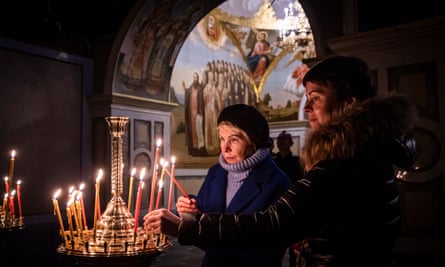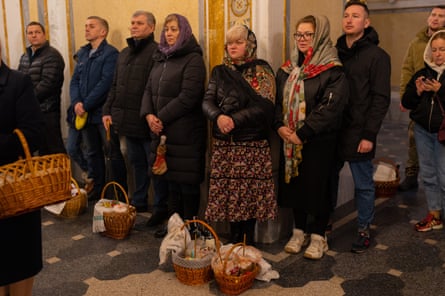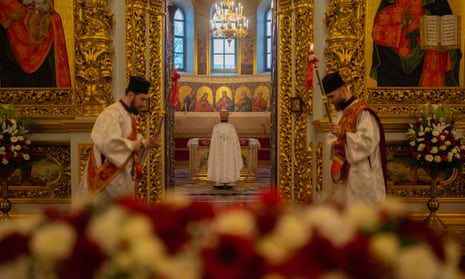Dawn did not break over wartime Kyiv on Orthodox Easter Sunday. It was more that the darkness gradually paled, leaving the pinnacle of the 18th-century bell tower wreathed in a wan mist.
Soon after 5.30am, the faithful began to trickle into Dormition Cathedral, which stands at the heart of the Kyiv Pechersk Lavra, or Monastery of the Caves.
Families carried wicker baskets, covered with hand-embroidered cloths and filled with sweet Easter bread, eggs dyed with onion skins, salt and meat. Members of the congregation, crossing themselves, lit candles; the great golden candelabra in front of the iconostasis were soon bristling with flames.
Easter has been celebrated on this spot since the 11th century, when monks from Mount Athos first hollowed out the rocky hillside to form their cells and shrines, establishing the lavra as the spiritual heart of eastern Orthodoxy.
But this year, change was afoot. For the first time since the 17th century, the Easter service was being conducted by clergy independent of the Moscow patriarchate. Or to put it another way, it was the Orthodox church of Ukraine (OCU) rather than the Ukrainian Orthodox church (UOC) presiding over the service.
From the outside, the difference between the two may seem a fine distinction. But in the Orthodox communion’s dizzying history of schisms, disputes over authority, and declarations of autocephaly (or self-governing status), politics has never been far away.
The Kyiv Pechersk Lavra has for centuries fallen under the authority of the Moscow patriarchate. But a number of the UOC’s clergy have recently been suspected of links to the Kremlin. In November, the Ukrainian security service, the SBU, conducted raids on the monastery complex, seizing pro-Russian literature, $100,000 in cash, and Russian passports.

Then last month the government, citing the lease through which the Moscow-affiliated UOC were granted tenancy of the monastery complex, announced the monks would be required to leave the premises by 29 March – unless they decided to join the OCU.
But many of the monks stayed put and stayed loyal to the UOC – and Metropolitan Pavlo, the vicar of the lavra, decided to challenge the eviction notice through the courts.
However, a few days later on 1 April he was put under house arrest until the end of May, accused of inciting religious hatred and condoning Russian aggression against Ukraine – a decision he is appealing against.
So it was that this year’s Easter morning service was led by Archimandrite Avraamiy, the acting vicar of the lavra from the OCU – which itself was born in 2018 out of two previously separate Ukrainian Orthodox churches.
Amid the joy of the service, there were tensions. A large police cordon stood before the narrow gates of the lavra, inspecting visitors’ documents.

Before the service began, a young man, who did not give his name, said: “I just came here to look at this circus. They’ve taken it away from the true church. OK, it technically belongs to the state, but they never did anything to look after it.” He added: “Why are they checking people’s documents? They never did that before.”
But then the great silver doors of the iconostasis opened and a wave of incense engulfed the congregation. The solemn voices of the choir – the deep baritones and great vibrating basses – began to sound, but out of sight, as if the whole building was resonating with chants and song.
Brilliantly lit by great golden chandeliers, the walls of the cathedral blazed with murals of hundreds of bearded saints and prophets, and Christ crucified stared down from the apex of the iconostasis.
In a complex, repetitive dance, the clerics emerged in pairs: one would swing the thurible, spreading the fug of incense; the other, white-robed with a red-and-gold sash across his body, would follow behind with a tall golden candlestick. Then came the great cry of “Christ is risen,” to which the congregation returned: “He is risen indeed.”
Outside the cathedral – rebuilt in the 1990s, the retreating Soviet army having blown up the original in 1941 – the faithful were queueing to have their Easter baskets blessed and sprinkled with holy water by a cleric wielding an aspergillum (a kind of brush used for the purpose).
Angelika Yevdokymenko had homemade Easter bread, vegetables and salo, or lard, in her Easter basket – to be consumed for her holiday breakfast and with guests in the evening. She had come to the cathedral last year, she said, and here she was again. As long as things were done legally, it was all right with her.

Denys Bitukov, originally from Sumy in north-east Ukraine and now a trooper in a reconnaissance unit, shared a brief kiss with his partner after the blessing – albeit a damp one after the priest’s energetic spraying of holy water.
Bitukov had a point to make by being here. “The churches of the Moscow patriarchate blessed the war, and approved the killing of our children,” he said, referring to the close association of Vladimir Putin with Patriarch Kirill of the Russian Orthodox church. “In my soul I cannot go to Moscow churches. I am a warrior.”
Filip Trunov and Anastasia Kamenska, a young couple originally from Lysychansk in the Luhansk region, a city under Russian occupation since the summer, had brought branches of pussy willow, which in Ukrainian tradition is associated with health and strength.
“We’ve come here because it’s one of the biggest churches of Kyiv – and now it is a Ukrainian church,” said Trunov. “If we need churches at all, we need Ukrainian churches.”
